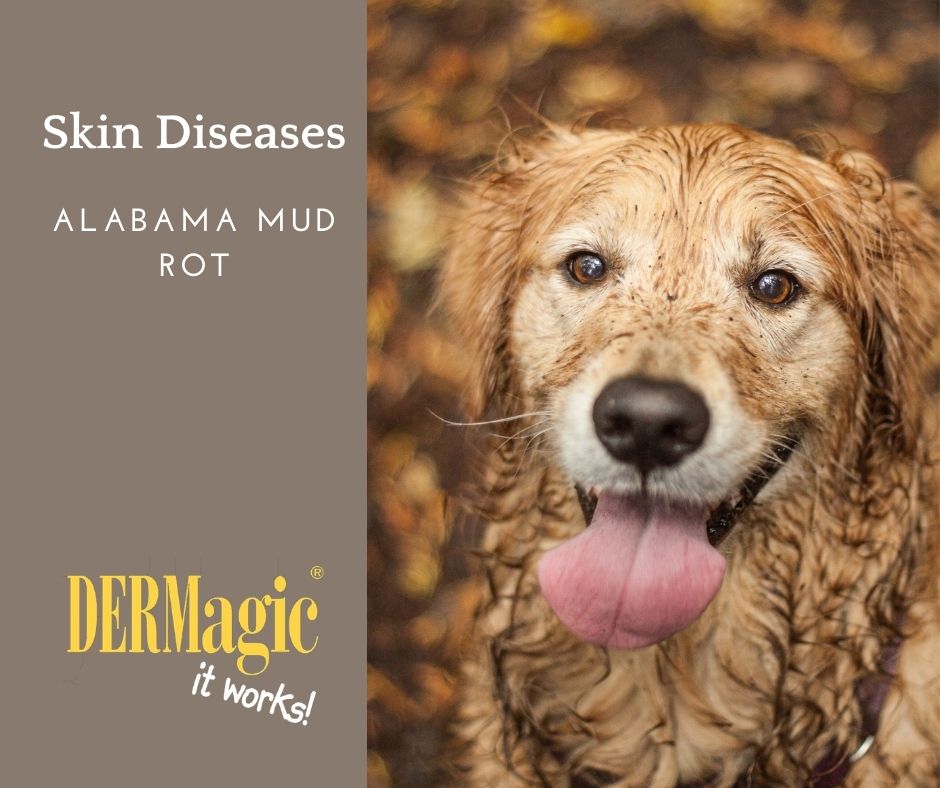
If you live in the deep south, chances are good you've heard about Alabama Rot (also known as "Cutaneous and Renal Glomerular Vasculopathy" or "CRGV").
But, if you haven't heard of this condition, it's time to read up. Cases have been spreading throughout the US and UK, as well as other locales.
This disease blocks the blood vessels in your dog's skin and kidneys, resulting in ulcers and sores and (in 9 out of 10 cases), death.
What in the world is Alabama Rot?
Alabama Rot is a tricky disease and diagnosis can sometimes be challenging and the cause isn't really understood.
However, vets believe that wet, muddy conditions are the main culprit as the majority of dogs who have died from Alabama Rot had been roaming the muddy woodland areas of Alabama prior to growing ill.

How common is Alabama Rot?
The first reports of Alabama rot came from the state of Alabama in the 1980s.
However, it has since spread around the world.
Most recently, there has been a high incidence rate in the UK. Whether this is due to vets being more aware of the condition and diagnosing it properly, or if it's simply on the rise is yet to be determined.
Which dogs are most susceptible to Alabama Rot?
At the time it was first diagnosed, it appeared that only greyhounds were affected. It is now known that any breed can contract the disease.
We now know that Alabama Rot is not breed, age, sex or weight dependent. Most cases appear to happen between November and May, although that seems to be changing as our weather patterns evolve. A small number of cases were reported during summer months.
The only real good news is that it seems to be focused solely on canine. Other animals and humans seem to be unaffected.
Symptoms of Alabama Rot
This condition generally begins with ulcers on the legs or paws. But, there have been more cases starting with ulcers and sores on the head, belly, nose and mouth, and even on the tongue. Symptoms to watch for include:
- Skin lesions and open sores on body, head, or tongue.
- Going off food.
- Changing drinking habits (too little or too much water consumed)
- General malaise - or appearance of being ill.
- Easily tired or refusal to play.
Diagnosis of Alabama Rot
There are no tests to determine Alabama Rot. Your vet will rely on bloodwork to evaluate your dog's kidney values and evaluate symptoms. The only real way to definitively identify this disease is a post-mortem examination of the kidney.
Treatment of Alabama Rot
Treatment is largely dependent on symptoms. Most treatments are non-invasive and supportive. At this time, the majority of cases are fatal.
There is a window of approximately ten days from exposure to diagnosis, so early care is your dog's best bet.
Prognosis of Alabama Rot
Sadly, Alabama rot is fatal in nine out of 10 dogs. It's not only the cause that's unknown, but also the cure.
The only way to identify this disease is by evaluating the kidney after death. This is why the outlook is grim - we simply don't have enough data to identify how many dogs have recovered.
Prevention of Alabama Rot
There is still a lot that researchers are discovering about this disease.
While we aren't entirely sure of the cause, it's a good idea to:
- Rinse dogs if they have been playing in mud.
- Watch for early signs.
- Check your dog's body daily for changes.
- Contact your veterinarian if you observe signs.
Learn more about Alabama Rot
There are several organizations running detailed studies on Alabama Mud Rot. In the UK, the Alabama Rot Research Fund (ARRF) is raising funds to promote research into all aspects of the disease in hopes of advancing education, guiding treatment and offering prevention strategies.
Sources:
- Carpent, J. L.; et al. (1988). "Idiopathic Cutaneous and Renal Glomerular Vasculopathy of Greyhounds". Veterinary Pathology. 25 (6): 401–407. doi:10.1177/030098588802500601. PMID 3212884
- Easley, J.R.; (1979) "Necrotizing Vasculitis in a group of Beagles"
JR Easley - Journal American Animal Hospital Association, 1979 - agris.fao.org

